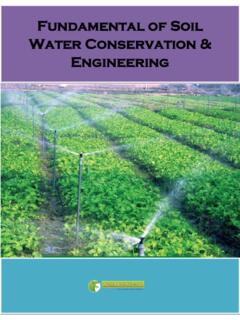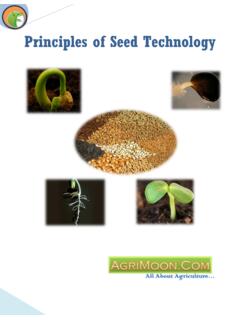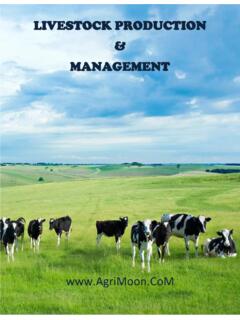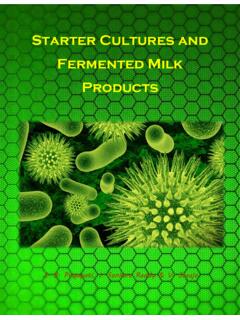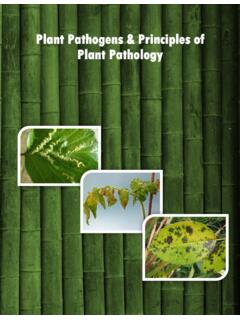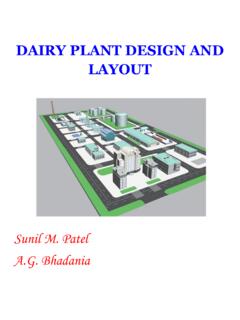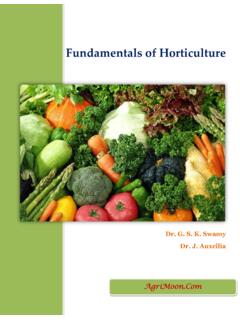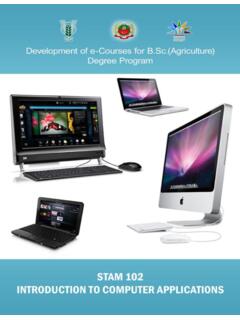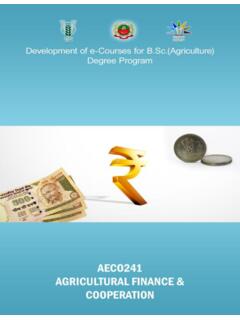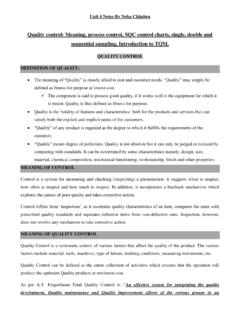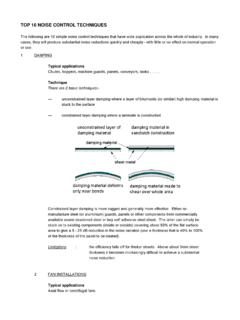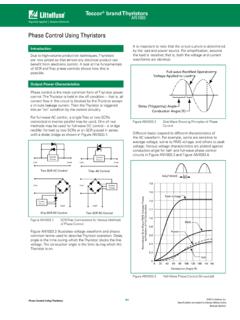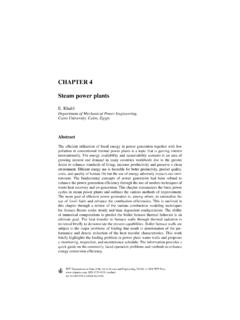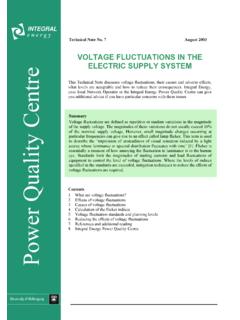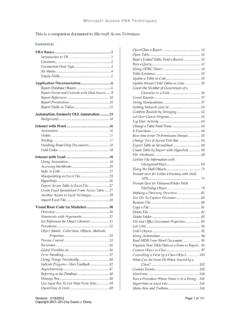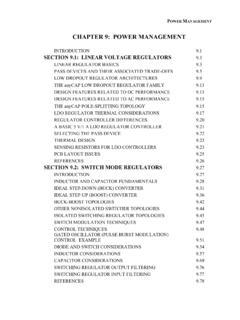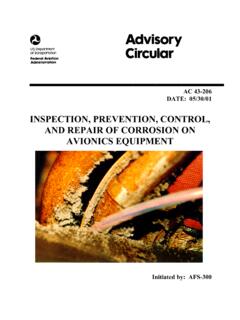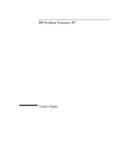Transcription of INSTRUMENTATION AND PROCESS CONTROL - AgriMoon
1 INSTRUMENTATION AND PROCESS CONTROL INSTRUMENTATION and PROCESS CONTROL Author Sawhney, S. K. Chaudhary & Sunil Kumar Dairy Engineering Division NDRI, Karnal Index Module 1: Instruments and measurement system Lesson 1 Functions of instruments and measurement system 5-9 Lesson 2 Elements of generalized measurement system 10-14 Module 2: Classification and selection of instruments Lesson 3 Classification of instruments 15-19 Lesson 4 Analog and digital modes of operation 20-25 Lesson 5 Instrument selection criteria and installation procedures 26-29 Module 3: Characteristics of instruments and measurement systems Lesson 6 Static characteristics of measuring instruments I 30-33 Lesson 7 Static characteristics of measuring instruments II 34-37 Lesson 8 Static characteristics of measuring instruments III 38-40 Lesson 9 Dynamic characteristics of measuring instruments 41-45 Module 4.
2 Induction type indicating instruments Lesson 10 Essentials of indicating instruments 46-49 Lesson 11 Principle of induction type instruments 50-53 Lesson 12 Induction type voltmeter and ammeter 54-56 Lesson 13 Induction type wattmeter, watt-hour meter, dynamometer type power factor meter 57-61 Module 5: Transducers Lesson 14 Introduction to sensors and transducers 62-67 Lesson 15 Mechanical input transducers 68-72 Lesson 16 Electrical transducers: Resistive transducers 73-76 Lesson 17 Electrical transducers: Capacitive transducers 77-80 Lesson 18 Electrical transducers: Inductive transducers 81-86 Lesson 19 Measurement of pressure I 87-93 Lesson 20 Measurement of pressure II 94-97 Lesson 21 Measurement of pressure III 98-100 Lesson 22 Measurement of temperature I 101-105 Lesson 23 Measurement of temperature II 106-111 Lesson 24 Measurement of liquid level 112-117 Lesson 25 Measurement of flow 118-123 Lesson 26 Measurement of speed and humidity 124-128 Module 6: PROCESS CONTROL Lesson 27 Elements of generalized PROCESS CONTROL 129-135 Lesson 28 CONTROL system parameters 136-139 Lesson 29 Types of controller modes 140-144 Lesson 30 Final CONTROL elements and actuators 145-150 Lesson 31 INSTRUMENTATION and controls in dairy plant 151-155 Lesson 32 INSTRUMENTATION and controls in CIP and sanitizing 156-159 References 160 Module 1.
3 Instruments and measurement systemLesson 1 FUNCTIONS OF INSTRUMENTS AND MEASUREMENT IntroductionDairy processing unit operations mainly involve heating, cooling, separating, drying or freezing of the unit operations are carried out under varying conditions of temperatures, pressures, flows and physicalcompositions. The measurement and CONTROL of these variable factors at the various stages of processing call forthe accurate and efficient instruments, in addition to the dependence upon human skills. With the advent of largescale milk handling plants the automatic operation and CONTROL through efficient INSTRUMENTATION and automationhas become even more necessary. Utilities such as steam, water, electricity air, fuel etc. have to be measured andcontrolled at appropriate points in the plant. Automatic CONTROL instruments are employed to measure and controlthe temperature, pressure, flow and level of these utilities.
4 The overall aim of the INSTRUMENTATION / automation isto improve the product quality and enhance the plant efficiency for better economic returns. VariableA characteristic number or quantity that increases or decreases over time, or takes different values in differentsituations is known as Variable. It is a factor that can be assigned a measurable dimension of some kind thatvaries, , length, diameter, area, flow, weight, cost or life-span etc. A dependent variable is any measurablefactor whose behavior is controlled by another variable. An independent variable is any measurable factor thatproduces change or reaction in another variable. A variable is something that is changed or altered in anexperiment. In processing of food products the variables involved could be temperature and pressure of steam,processing time, flow rate of various streams etc. For example, to determine the effect of temperature andhumidity on storage of a food product will provide evidence on the shelf life of product in different storageconditions.
5 Variable is liable to change, may have a range of possible values and is liable to deviate from anestablished extension MeasurementWhen we decide to study a variable we need to devise some way to measure it. Some variables are easy tomeasure and others are very difficult. The values of variables are made meaningful by quantifying them intospecific units. For example, instead of saying that a particular fluid is hot, we can specify a measurement andspecify that the fluid is having a temperature of 80 C. Measurement is collection of quantitative data. Ameasurement is made by comparing a quantity with a standard unit. An example of measurement means the useof a ruler to determine the length of a piece of is thus essentially an act or the result of comparison between the quantity (whose magnitude isunknown) and a predefined standard. Since both the quantities are compared, the result is expressed in numericalvalues.
6 In the physical sciences, quality assurance, and engineering, measurement is the activity of obtaining andcomparing physical quantities of real-world objects and events. Established standard objects and events are usedas units, and the PROCESS of measurement gives a number relating the item under study and the referenced unit and PROCESS are two essential requirements of the measurements, in order to make the results meaningful;(i) The standard used for comparison purposes must be accurately defined and should be commonly accepted.(ii) The apparatus used and the method adopted must be Unit of MeasurementA unit of measurement is a definite magnitude of a physical quantity, defined and adopted by convention and/orby law, that is used as a standard for measurement of the same physical quantity. Any other value of the physicalquantity can be expressed as a simple multiple of the unit of measurement.
7 For example, length is a physicalquantity. The metre is a unit of length that represents a definite predetermined length. When we say 10 metres(or 10 m), we actually mean 10 times the definite predetermined length called "metre".The definition, agreement, and practical use of units of measurement have played a crucial role in humanendeavour from early ages up to this day. Different systems of units used to be very common. Now there is aglobal standard, the International System of Units (SI), the modern form of the metric International System of Units (abbreviated as SI from the French language name Syst me Internationald'Unit s) is the modern revision of the metric system. It is the world's most widely used system of units, both ineveryday commerce and in science. The SI was developed in 1960 from the metre-kilogram-second (MKS)system, rather than the centimetre-gram-second (CGS) system, which, in turn, had many variants.
8 During itsdevelopment the SI also introduced several newly named units that were previously not a part of the metricsystem. The original SI units for the six basic physical quantities were: metre (m) : SI unit of length second (s) : SI unit of time kilogram (kg) : SI unit of mass ampere (A) : SI unit of electric current degree kelvin (K) : SI unit of thermodynamic temperature candela (cd) : SI unit of luminous intensityThe mole was subsequently added to this list and the degree Kelvin renamed the are two types of SI units, base units and derived units. Base units are the simple measurements for time,length, mass, temperature, amount of substance, electric current and light intensity. Derived units are constructedfrom the base units, for example, the watt, the unit for power, is defined from the base units as m2 kg s physical properties may be measured in compound units, such as material density, measured in Significance of MeasurementsScience is based on objective observation of the changes in variables.
9 The greater our precision of measurementthe greater can be our confidence in our observations. Also, measurements are always less than perfect, ,there are errors in them. The more we know about the sources of errors in our measurements the less likely wewill be to draw erroneous conclusions. With the progress in science and technology, new phenomena andrelationships are constantly being discovered and these advancements require newer developments inmeasurement systems. Any invention is not of any practical utility unless it is backed by actual measurements thus confirm the validity of a given hypothesis and also add to its understanding. This is aInstrumentation and PROCESS chain that leads to new discoveries with new and more sophisticated measurement techniques. Whileelementary measurements require only ordinary methods of measurement, the advanced measurements areassociated with sophisticated methods of measurement.
10 The advancement of Science and Technology istherefore dependent upon a parallel progress in measurement techniques. It can be safely be said that, theprogress in Science and Technology of any country could be assessed by the way in which the data is acquiredby measurements and is R&D applications the design of equipments and processes require the basic engineering design data on theproperties of the input raw materials and processed products. The operation and maintenance of equipments foroptimal processing variables to achieve best quality product and energy efficient equipment utilization requirethe monitoring and CONTROL of several PROCESS variables. Both these functions require measurements. Theeconomical design, operation and maintenance require a feedback of information. This information is suppliedby appropriate measurement Function of Instrumentals and Measurement SystemsThe measurement systems and the instruments may be classified based upon the functions they perform.
